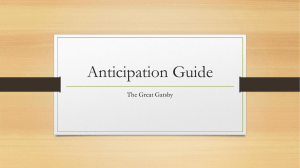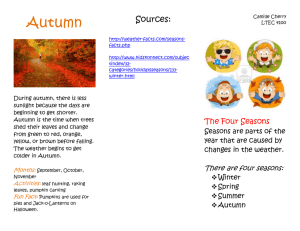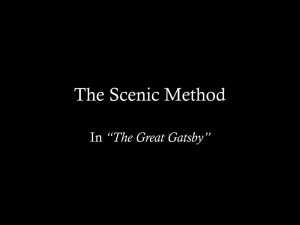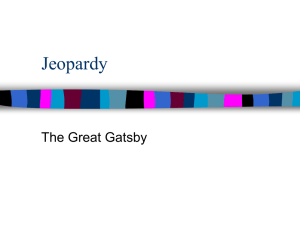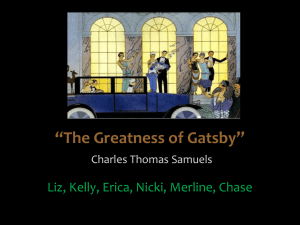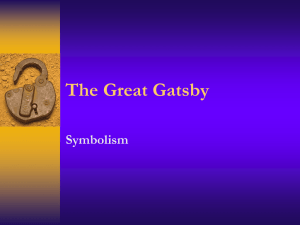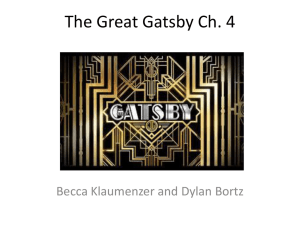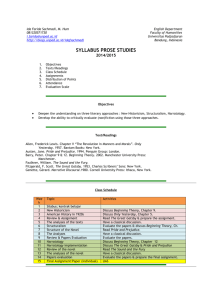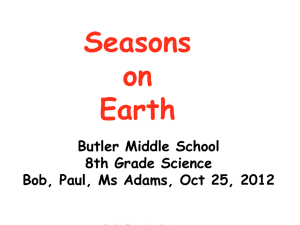Seasonal Symbolism
advertisement
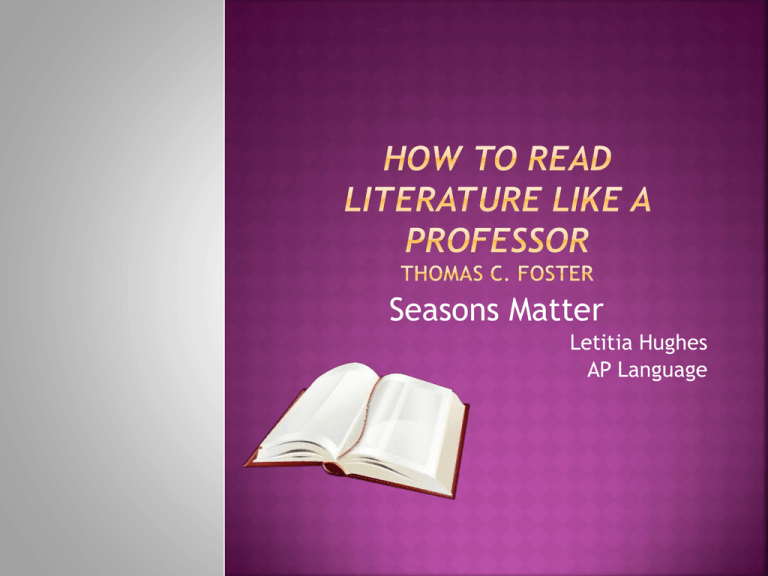
Seasons Matter Letitia Hughes AP Language “ F. Scott Fitzgerald, The Great Gatsby (1925), “If modern American literature consisted of only one novel, and if that novel were Gatsby, it might be enough. What does the green light mean? What does Gatsby’s dream represent? And what about the ash heaps and the eyes on the billboard?” Shakespeare’s sonnet 73 That time of year thou mayest in me behold When yellow leaves, or none, or few, do hang Upon those boughs which shake against the cold: Bare, ruined choirs, where late the sweet birds sang. Page 175 The Speaker is seriously feeling his age here and making us feel it, too, with those boughs shaking in the cold winds, those last faded leaves still hanging, if barely, in the canopy, those empty limbs that formerly were so full of life and song. His leaves, his hair, have mostly departed, we can surmise, and his appendages are less resolute than formerly, and of course, he’s entered a quieter period than his youth had been. November in the bones; it makes my joints ache just to think about it. This fall/middle-age cliché was pretty creaky in the knees long before the Bard got a hold of it. What he does with the metaphor is to invest it with a specificity and a continuity that force us to really see not only the thing he describes- the end of autumn and the coming of winter- but the speaker’s standing on the edge of old age. “Shall I compare thee to a summer’s day? Thou art more lovely and more temperate” King Lear is raging in his old man’s madness in a winter storm. Midsummer night is the time when young lovers escape to the woods to sort out their romantic difficulties and take their place in the adult world. More Bard Examples as titles… A Winter’s Tale Twelfth Night (the last of the twelve days of Christmas) A Midsummer Night’s Dream Henry James employed this metaphor in his novel Daisy Miller, rather than writing directly about geopolitical conflicts, he lets his characters serve as metaphors for the new American republic and the rule-bound Europe. Daisy is a young, fresh, direct, open American girl. She’s all spring and sunshine. Frederic Winterborne is an American man but a long-time resident in Europe, slightly older, jaded, worldly, emotionally closed, indirect and totally dependent on the good opinion of others. If you pay attention to the name game, you can tell things will end badly – daisies can’t flourish in winter. Classic examples: Mamas and Papas express dissatisfaction with winter, gray skies, and brown leaves and do some “California Dreamin’.” Simon & Garfunkel cover the same unhappy ground in “A Hazy Shade of Winter.” Rod Stewart’s “Maggie May” says he’s waiting around too long wasting his time on an older woman in September. Why that month? Guns n’ Roses “November Rain” Can you name any contemporary examples of seasonal symbolism in song lyrics? Kenny Chesney Spring is childhood and youth. Summer is adulthood and romance and fulfillment and passion. Autumn is decline, middle age and tiredness but also harvest. Winter is old age, resentment and death. W.H. Auden’s elegy “In Memory of W. B. Yeats” (1940) Annotate the poem for diction related to winter / coldness. Excerpt from Section I He disappeared in the dead of winter: The brooks were frozen, the airports almost deserted, And snow disfigured the public statues; The mercury sank in the mouth of the dying day. What instruments we have agree The day of his death was a dark cold day. Robert Frost did not specify a season in his poem “After Apple Picking” but the metaphor exists. Annotate the poem for this metaphor Analyze the time of day, tone, mood and point of view. Author’s make conscious choices regarding seasons….. Will summer be warm, rich and liberating or hot, dusty and stifling? Will autumn find us toting up our accomplishments or winding down, arriving at wisdom and peace or being shaken by those November winds? Analyze the symbolism of seasons in this classic novel. Getting started.. The weather in the novel unfailingly matches the emotional and narrative tone of the story. Examples: Gatsby's and Daisy's reunion begins amid a pouring rain, proving awkward and melancholy (a gloomy state of mind) Their love reawakens just as the sun begins to come out. Gatsby's climactic confrontation with Tom occurs on the hottest day of the summer, under the scorching sun (like the fatal encounter between Mercutio and Tybalt in Shakespeare's R and J). Wilson kills Gatsby on the first day of autumn, as Gatsby floats in his pool despite a palpable (you can feel it) chill in the air.
